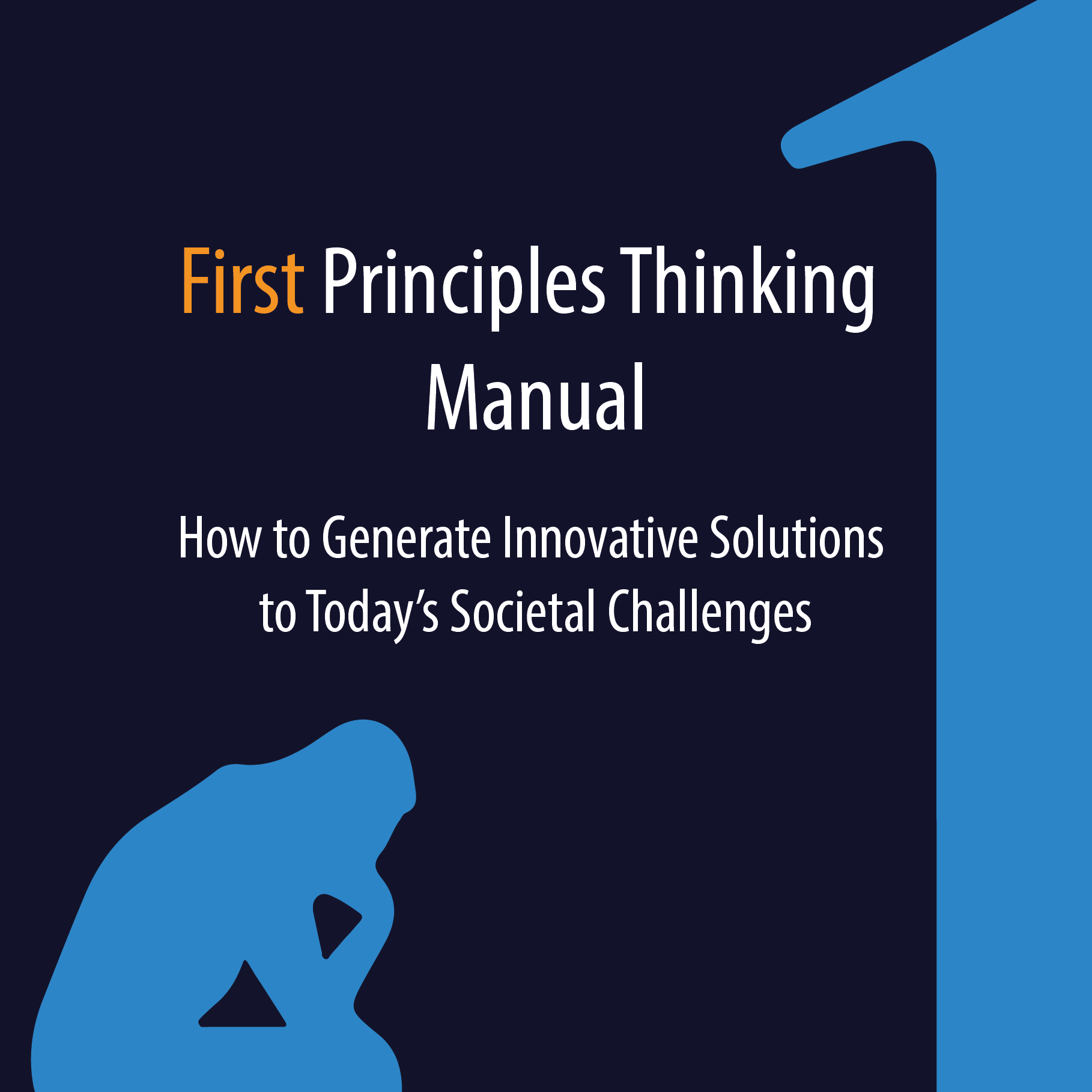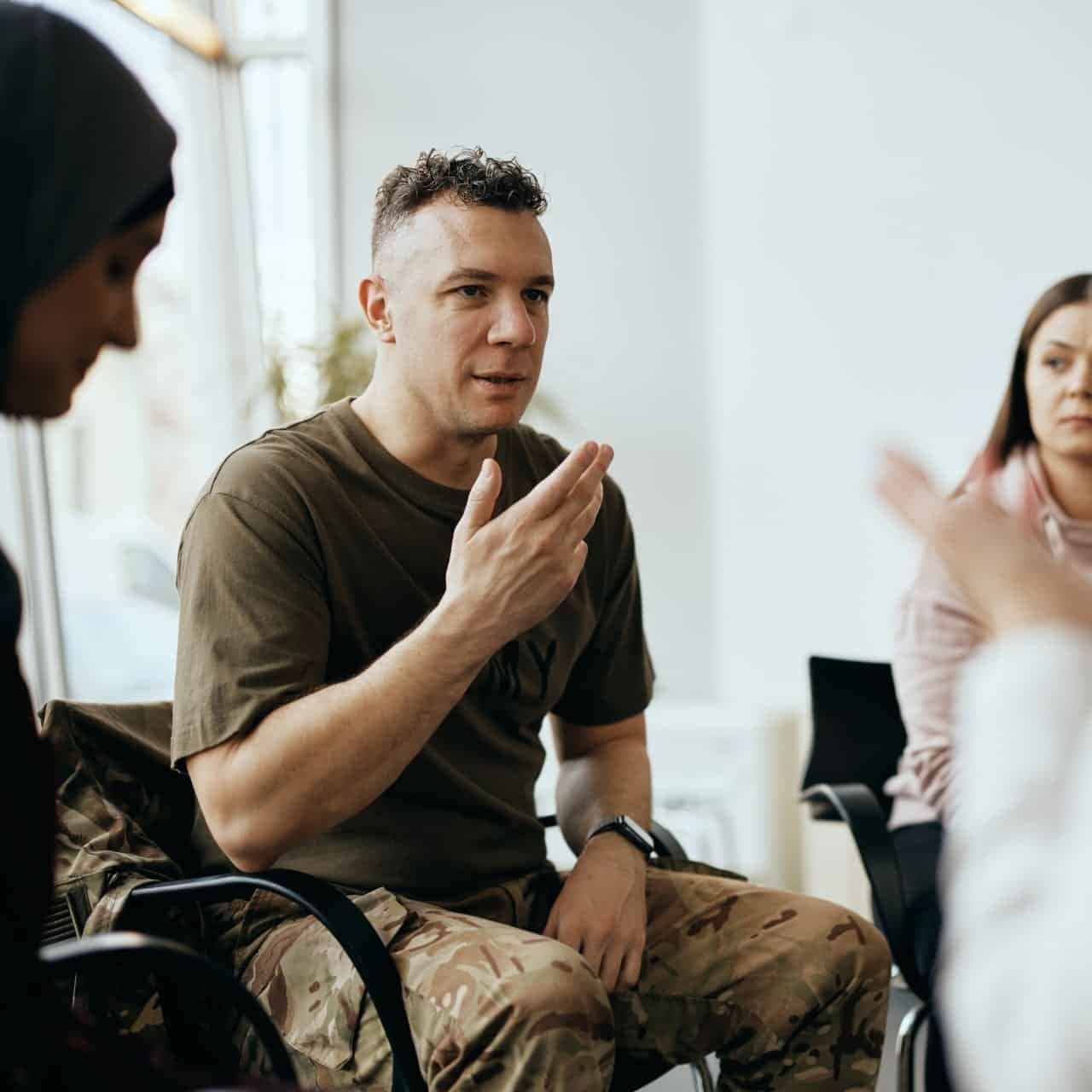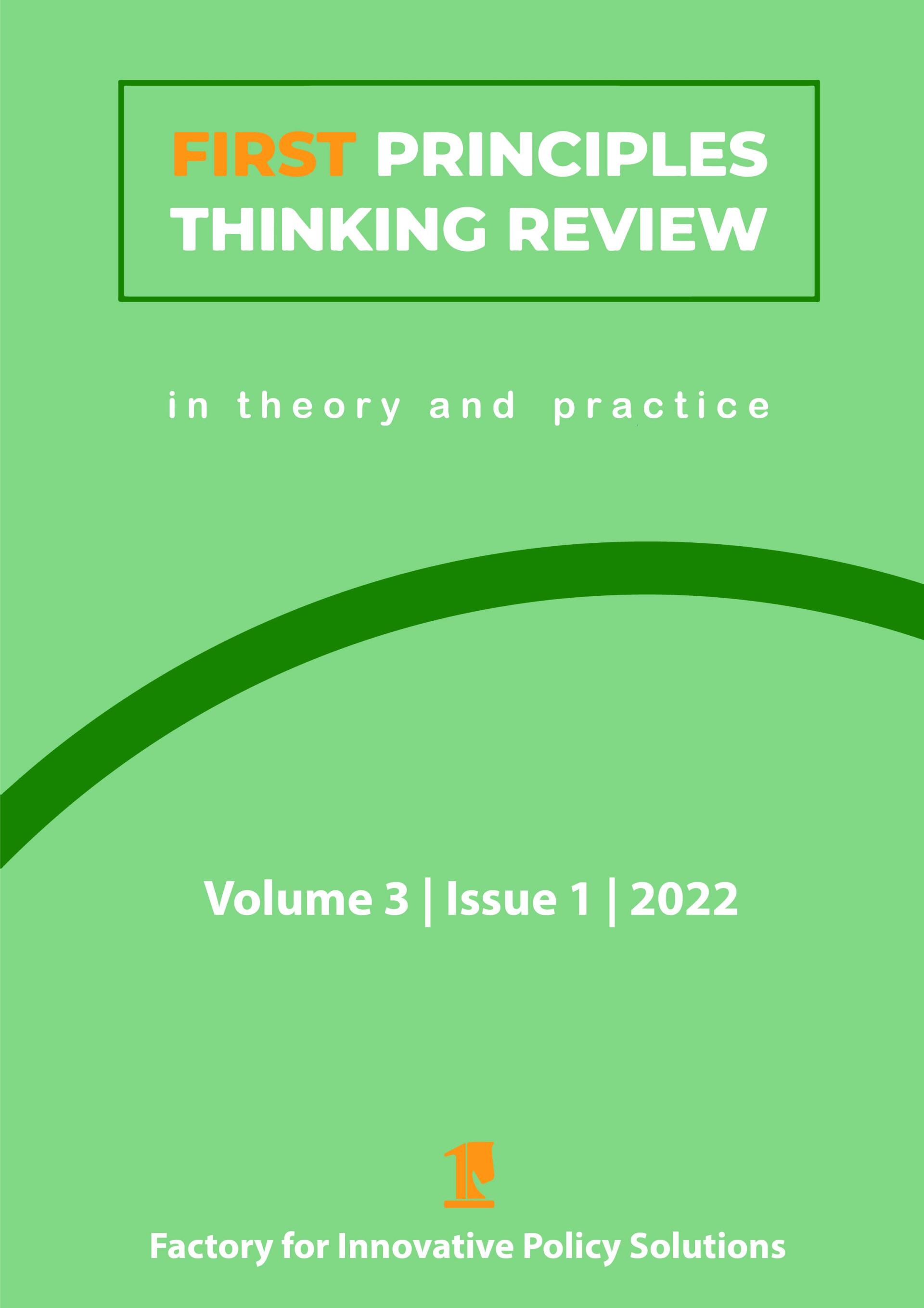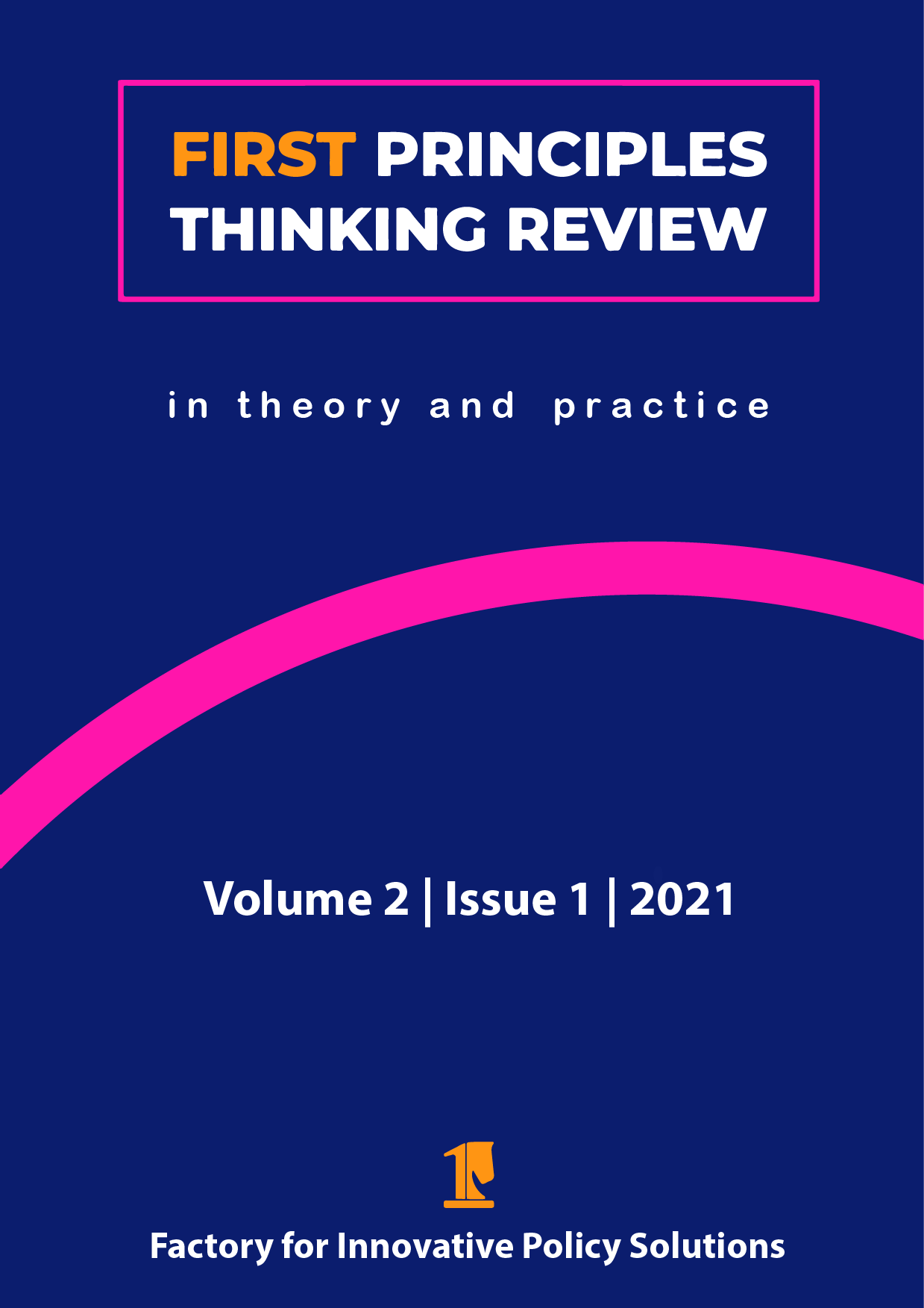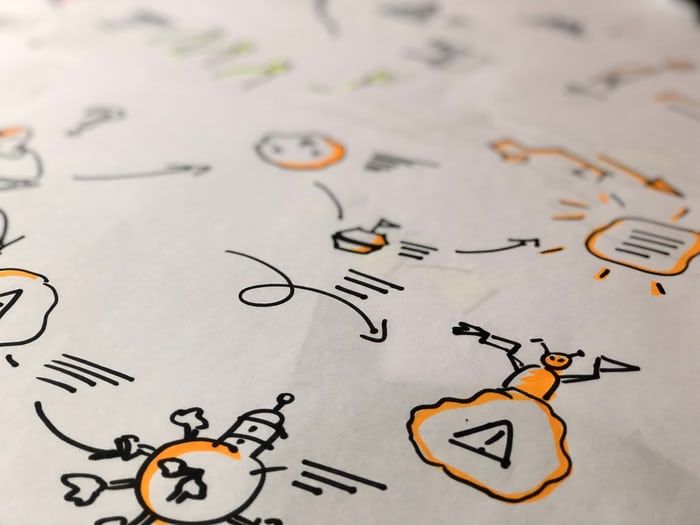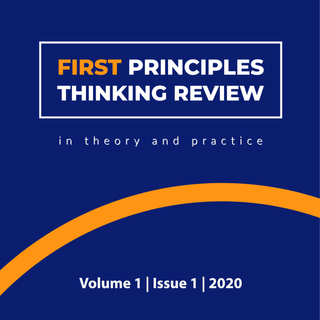Can First Principles Thinking Spur Creative Ideas About Peace?
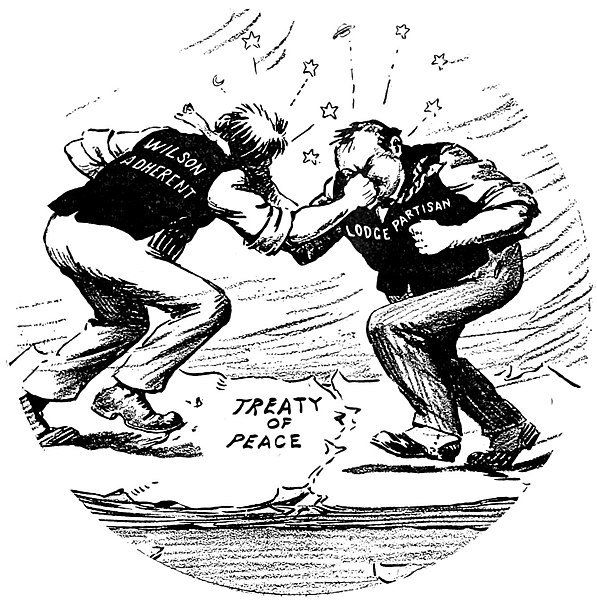
Photo by Nelson Harding
Does the language we use to talk about peace prevent peace? Defining peace in terms of conflict and violence seems to restrict peace-related activities to matters requiring negotiation, conflict resolution and violence prevention, and to evoke delimited emotional responses. I sense that new ideas about peace could only come from a systematic, first principles approach to a topic that is accepted as a social good but rarely examined this way. Perhaps such an exercise would strip back the concept to reveal the root experiences, behaviors and emotions we point to when we say, ‘this is peace’. I hope that by identifying the first principles of peace it might generate creative ideas to enable a new perception of peace, beyond the absence of violence, and that could be used to effectively promote peace.
Keywords: First principles thinking, peace, conceptualization
Introduction
The way we currently think and talk in English about social peace connects the concept inextricably to violence, war, conflict and injustice, particularly in the fields of international peace research and theory. This view has been held by prominent peace researchers and theorists for decades: “What we intend is that the terms 'peace' and 'violence' be linked to each other such that 'peace' can be regarded as 'absence of violence’” (Galtung, 1969, p.167). Violence and injustice, in any form, is a societal challenge. Although intimidated by the scale of the topic of peace, I want to apply first principles thinking to the starting point of our thought framework: the language we use. I restrict my inquiry to the language of my own culture, English-speaking western democracies.
It seems to me that the current activities of peace, such as conflict resolution and the appeasement of violent offenders, are certainly individually necessary, but not jointly sufficient for social peace to prevail. I see a parallel with the observation of Seligman and Csikszentmihalyi in their paper, Positive Psychology: An Introduction (2000) in which they observe: “What psychologists have learned over 50 years is that the disease model does not move psychology closer to the prevention of [these] serious problems” (p.7). They propose an approach focused on the scientific study of the factors contributing to optimal human functioning and well-being to learn how human beings thrive and flourish. I wonder if the ‘disease model’ of violence and civil injustice I saw in current peace theory, research and teaching was having the same effect of “not moving us closer to the prevention of these serious problems”.
Because positive psychology is “the study of the conditions and processes that contribute to the flourishing or optimal functioning of people, groups, and institutions” (Gable & Haidt, 2005, p.103), I wonder about the possibilities for thriving, flourishing human communities that might remain unrealized while ever we talk and think about peace with reference to violence (Galtung, 1969). Violence is central to even the most innovative conceptualizations of peace, including the prominent theorist Galtung’s notion of “positive and negative peace”, where negative peace is the absence of violence or war, and positive peace is the integration of human society. It seems to me, as a member of the general public, that Galtung’s definition of positive peace as the integration of human society has been obscured by the more widely held definition of negative peace. Can new language for peace give new life to this vision of positive peace?
There is an unusual opportunity for mindset change now, particularly in digital content on peace-related websites, Facebook groups and other social media, and video platforms such as YouTube and Vimeo. The English language had an early lead in online content and maintains dominance today (W3Techs, n.d.). By addressing the language of peace in a first principles thinking exercise, could creative ideas for framing peace independent of violence emerge and be widely disseminated, particularly online? Could creative ideas be generated for all aspects of peace?
If it is true that the way in which we currently talk and think about peace directs our behavior and emotional responses towards violence prevention and safety, it suggests that fear is the motivating factor. Although this paper is not the place for a discussion on the fight/flight/freeze responses of the parasympathetic nervous system, there is evidence that it has a direct impact on whether we feel threatened by others or safe in our social engagement (Porges, 2009). I wondered if it might be possible to think and talk about peace so that our peace behaviors are directed to those activities that promote positive social engagement rather than activities focused on fear-based defense responses. If that were possible, could peace eventually be defined by dictionaries, by ordinary people and peace ‘professionals’ alike, as a range of behaviors (and resulting emotions) motivated by social connection and not by social threat? Could that shift be of benefit to society? I believe it could.
We define, think, and talk about peace as a state of being to be achieved through the actions of conflict resolution, violence cessation and prevention. As influential peace educator Betty Reardon states, “I identify violence as the central problematic of peace education” (Reardon, 2015, p.55). In English, peace is a noun and not a verb, and is difficult if not impossible to imagine without reference to conflict, war and violence. As the old bumper sticker jokes, “Imagine Whirled Peas”. If we had new language for peace, would our imaginations and emotions be engaged differently? Would we generate new visual, conceptual, and linguistic metaphors to better communicate and teach peace? Could peace become a verb describing specific relationship behaviors unrelated to violence?
What is the objective?
My overarching goal is to improve the teaching of peace and the way it is communicated so that it centers on rebalancing social relationships at a far earlier point in the conflict dynamic than a focus on violence currently allows. I have a three-fold objective for this inquiry, centered on language and meaning:
- To revitalize the language and meaning frameworks used in English to think and talk about social peace in order to enhance the peace community’s ability to teach and promote peace at all levels of society.
- To bring about a mindset change within the peace community of practitioners, theorists, researchers, activists and lay people interested in promoting social peace.
- To identify fundamental human relationship behaviors and emotions descriptive of the experience of peace.
What are the obstacles to this objective?
I identify eleven major obstacles to this compound objective:
- Historical language for peace that refers to violence, war and conflict must be overcome if new ways of framing social peace as a distinct activity and experience of human flourishing are to be achieved because new frameworks of thought require new language.
- The vocabulary we use to think and talk about peace is currently limited and must be enlarged to include the experience of peace in which violence is not included.
- The current mindset must be open to change if we are to perceive peace as a fundamental human experience essential to maintaining positive relationships of mutual value.
- The language that gives rise to the description of peace as primarily an emotionally subdued experience (calm, serenity, relief) must be overcome so that teaching and communication regarding peace is more emotionally accurate and engaging.
- Western epistemological and philosophical traditions of peace which follow a cognitivist view of emotions that render social knowledge separate from bodily experience must change to permit a new embodied knowledge of peace.
- The preponderance of current research and theory about peace which relies on rational and historical argument rather than on lived experience must be overcome if peace is to be positively reframed.
- Language that signifies peace as a static state of being must be changed to correctly communicate peace as a teachable range of actions fundamental to recalibrating relationships of increasing mutual value.
- Relegating peace to the domain of specialist practitioners must be overcome to bring peace into the day-to-day experience of ordinary relationships.
- Visual and physiological metaphors for peace that do not include reference to human relationships (doves, olive branches, peace symbols) must be reframed/reinvented to communicate peace as a relationship-based experience.
- The unexamined assumption that peace is simple, obvious and need not be challenged must be overcome to gain an accurate picture of the full experience of peace rather than what peace is not.
- The focus of peace literature and research must shift from peace as a static temporary state between parties in disintegrated relationships (that is, relationships in which there is chronic and unresolved conflict, violence and is of diminishing mutual benefit to the parties) to peace as a set of dynamic characteristics of flourishing human relationships (that is, a set of characteristics or ways of relating to each other such that the relationship is of increasing mutual value to the parties involved).
Reduce the obstacles
Because peace is a large topic, it is obviously impossible to take on the entire problem of the possible negative consequences of a view of peace that is focused on violence, war and injustice. Despite narrowing the problem to the language and thinking used for peace in English-speaking western democracies, I have challenges in circumscribing the scope of my inquiry. It is necessary to reduce the number of obstacles, which I do based on the viewpoint of being a writer fascinated with the English language, a student of peace and conflict matters, a meditation teacher and conflict resolution professional, and a lay community member motivated to work for peace. I reduce the number of obstacles to 6 from my original 11:
- The historical language of peace that refers to violence, war and conflict must be overcome if new ways of framing social peace as a distinct activity and experience of human flourishing are to be achieved.
- Language that signifies peace as a static state of being must be changed to correctly communicate social peace as a teachable range of actions fundamental to recalibrating relationships of increasing mutual value.
- Identifying peace as emotionally quiet, weak, naïve, and intrapersonal in nature must be overcome so that teaching and communication regarding social peace is more emotionally accurate of the life-enhancing qualities of peaceful relationships as well as more engaging, and more stimulating than violence.
- Visual metaphors for peace that do not include reference to human relationships (for example, doves, olive branches, peace symbols) must be recreated in order to communicate peace as a synergistic relationship-based embodied experience.
- Relegating peace to the domain of specialist practitioners focused on political conflict and injustice must be overcome to broaden the experience of peace to include all social relationships.
- The continued focus within the culture of peace theorists, researchers and educators on peace as conceptually inextricable from violence is resistant to change and must be widened to overcome the current educational and research paradigm.
If these obstacles could be overcome, then conditions would prevail that are individually necessary and jointly sufficient to achieve my objective of creating new language for peace, and for using the resulting new language and meaning to initiate a shift in the mindset of the general public as well as the community of professionals and activists working to promote social peace. It is a big ‘if’, given that entrenched cultural attitudes can be resistant to change, much less overcome, but I suspend disbelief and persevere with my first principles exercise. Next, I examine my assumptions.
What are the assumptions underlying each obstacle?
I list the assumptions that I think are underneath each obstacle and use Socratic questioning to examine those assumptions. I find this a challenging but very useful part of the process. It is challenging for me to engage in this process because so much of my own thinking about peace is largely reactive and related to my personal experience of interactions with colleagues in peace and justice activism, violence prevention, negotiation, conflict resolution, and restorative justice practice. In short, I realize that I have harbored many unexamined assumptions that I am now subjecting to systematic questioning for the first time. For example, this is the output of my questioning the assumptions I thought were underneath the first identified obstacle:
Obstacle #1: The historical language of peace that refers to violence, war and conflict must be overcome if new ways of framing social peace as a distinct activity and experience of human flourishing are to be achieved.
I assumed:
- That the language we use to talk and think about peace has shaped our thinking. Does language shape the way we think? Do we think in language? Do we exclusively think in language rather than, say visual imagery, sound, kinesthetic experience? Do individual words in a language change in meaning over time, even if the word remains the same? Do historical definitions and meanings for peace carry over into the current thinking in the same way?
- That peace activities have followed the accepted definition of peace and have therefore revolved around the linkage to violence/war/conflict. Do the activities of peace (making, building) always involve responses to violence and conflict? Is it possible to decouple peace from violence/war/conflict using the current language? Does talking about peace always mean talking about what peace is not?
- That the historical meaning of peace in English, as the absence or cessation of war/conflict, started with the Latin word for peace, pax. Does the English word peace derive from the Latin pax? What are the etymological roots of the Latin word and could that be different from the Latin definition? Did that root word in any way influence the current definition of peace in English? What are the connotations of the Latin word that found their way into the English definition of peace?
- That despite the long history of defining “peace as not war”, this definition hasn’t changed in any significant way in 2,000 years (since Pax Romana). Is this verifiable? Has the definition of peace in English changed from the way the Romans defined it? Can that definition be linked and dated to Pax Romana? What other definitions are there for the English word, peace?
- That most people in the field believe that peace is a simple concept, needs no explanation and need not be challenged conceptually. Is this true? Is there evidence that peace researchers and theorists have never challenged the concept? Does peace require explanation? What evidence is there that the peace community shares a definition of peace based on unquestioned acceptance of the historical usage? What leading theorists and researchers have explicitly defined peace in the traditional way and stated that the definition is sufficient for their purposes, or insufficient? Do peace theorists usually define the word, peace? Is there any dissention in the peace community about the definition of the word?
- That English dictionary definitions of peace reflect popular usage and meaning: peace is defined in terms of violence. Do compilers of dictionaries have criteria related to widespread usage before a word is added to a dictionary? Do dictionaries reflect the evolution in meaning of words based on common or published usage? How is this assessed? Do definitions of the word “peace” by influential peace theorists such as Galtung shape the general understanding of peace, in peace education, peace activism and among peace practitioners? And if so, what impact does this have on the general public understanding of peace?
- That social peace is not currently viewed as a distinct activity and experience of human flourishing. Is there evidence of this in social psychology and other domains? What is meant by “human flourishing” in society? How are the activities and experiences of social peace currently viewed by peace researchers?
I continue to apply Socratic questioning to each of the assumptions I identified:
- That most English-speaking people see the experience and processes of social/political peace as being distinct and different from that of intrapersonal spiritual peace.
- That the conclusions and insights of peace theories and research remain in the domain of political peace and do not devolve to the domain of ordinary interpersonal relationships.
- That for most people, peace carries connotations of utopian naivete, and that violence more truly reflects human nature.
- That peace and violence (war, armed conflict, etc.) are categorical opposites and are both moral concepts.
- That cultural concepts are subject to change in meaning over time.
- That peace is a social value.
- That emotion is a key source of motivation in the maintenance of social values.
- That individualism (independence and uniqueness) is more prevalent in English-speaking western democracies than collectivism (duty to in group and maintaining harmony across groups and nations).
Questioning each assumption leads me to look for evidence to support or disqualify each assumption. This part of the exercise was very stimulating and led me to new research, some of which validated my observations and assumptions, and led directly to verifiable facts and fundamental truths, that is, first principles.
What first principles do I discover?
- Humans use language to communicate socially and to think.
- Language shapes the way we think and influences perceptual decisions (Boroditsky, 2011).
- Mindsets, or the ways in which we think about something, directly impact the reality we experience (Crum & Langer, 2007).
- Changing our mindsets can produce physiological, psychological and behavioral changes (Crum & Langer, 2007).
- Peace has been defined with reference to conflict, war and social unrest for centuries (Roser, 2016).
- Dictionary definitions reflect popular language usage.
- Peace is defined as the absence of war or conflict; Peace is a noun in English (OED, n.d.).
- Metaphorical understanding is grounded in basic human experience via conceptual metaphors (Lakoff, 2008).
- Peace theories, research and practices are focused on the dynamics of war, conflict and violence (Galtung, 1969).
- Google image searches for visual symbols and metaphors for peace do not portray human beings in relationship.
- The behaviors and activities of peace relate to conflict resolution and violence prevention (Reardon, 2015).
- Positive psychology is concerned with individual and group well-being and human flourishing (Seligman & Csikszentmihalyi, 2000).
- Mutuality and reciprocity are components of healthy human relationships (Kane et al., 2012).
- Cultures change, and with cultural change come shifts in concepts, language and attitude (Varnum & Grossmann, 2017).
What creative ideas are generated from the first principles?
I generate many creative ideas from these first principles by asking “how to” or “how can we” questions. For example, taking the first principle “Language shapes the way we think and influences perceptual decisions”, I ask: “How can we revitalize the language of peace so that we avoid reference to conflict (current usage: non-violent, anti-war, cease fire, conflict resolution, etc.)”. I conceive these ideas:
- Examine the language we use to describe flourishing relationships and contrast it to the language of conflict resolution to find new language for peace.
- Create new terms, if necessary, for those aspects of behavior causally related to maintaining flourishing relationships of mutual value.
- Coin and publish new words to communicate the reframed meaning of peace as a transitive verb using the existing structures of English. For example, use the prefix en- to coin the verb ‘to enpeace’, in the same way that ‘to enjoy’ is the verb form of joy and ‘to encourage’ the verb form of courage.
- Create new metaphors based on the physiological experience of peace, such as the rebalancing of the body (in dance, in sport etc.); Address the non-verbal aspects of the language of peace and create new visual metaphors and imagery for peace.
As I ask “How can we” questions of each first principle, further creative ideas develop:
- Express the description and definition of the behaviors identified as peace terms of healthy relationships.
- Frame peace activism and practice in terms of the dynamics of flourishing social relationships rather than the dynamics of social pathology (violence and injustice).
- Describe what social behaviors to use in positive terms and refrain from using language that refers to unwanted social behaviors (violence, injustice).
- Develop accurate physiological metaphors for peace that refer to the continuous rebalancing involved in flourishing relationships and that mirror the processes of homeostasis in living systems.
- Identify physiological orientation and movement that relate to the exchange of positive energy in flourishing social relationships (rebalancing in dancing, skating, juggling, surfing, for example) that could form the foundation for new linguistic and visual metaphors for peace.
- Challenge metaphor analysts to examine embodied metaphors for peace.
- Engage artists and writers to generate new metaphors based on a reframed perception of social peace.
- Invite social psychologists and other researchers to investigate self-similarity in the dynamics and scaling of social relationships.
- Publish the research and experience of test subjects and researchers, specifically in English-speaking Western democracies, who have shifted their emotional and psychological responses to peace.
- Promote anecdotal, individual and informal research and testing of shifts in responses to peace, and publish on social media group platforms to invite general public comment.
- Reframe the traditional mindset of peace and test the results in a variety of stakeholder groups.
- Enlist influencers on social media and in entertainment to popularize the emotional attractiveness and naturalness of peace without reference to violence or conflict.
- Create platforms for holding conversations about the emotional experience of the activities of peace (podcasts, social media sites, entertainers, and visual artists).
- Correlate and publish examples of where cultural attitudes have shifted regarding peace, drawing parallels with cultural attitude shifts in other areas such as marriage equality, gender fluidity, corporal punishment of children etc. This could illustrate how pro-social benefits (such as increased tolerance, understanding and compassion for others) can accrue from shifts in entrenched cultural attitudes about how we relate to each other.
- Identify what human flourishing is in respect of healthy relationships and contrast that with pathology in relationships.
- Publish content related to the 5 pillars of positive psychology, PERMA (Positive emotion, Engagement, Relationships, Meaning, Accomplishment) and show how each domain relates to peace (Seligman, 2012).
- Create an analogy to PERMA for peace.
- Frame peace activities as a continuum that describes human relationships with pathology at one end and flourishing at the other.
- Frame conflict as a natural feature of human interaction, and as a necessary impetus to positive change when handled skillfully.
- Demonstrate the constraints on a comprehensive view of peace that derive from a focus on violence and conflict.
- Invite and challenge peace researchers and theorists to concentrate their research on peace in terms of human flourishing in societies.
Conclusion
To paraphrase Marcus Aurelius, could the problems of the language of peace contain the solution? I am encouraged by this exercise in first principles thinking to see how the solution might emerge from the current language and metaphor English speakers use for peace. Of course, I am now tempted to apply first principles thinking to other aspects of peace. I plan to start a non-profit organization to implement and stimulate creative ideas to promote peace around the world, and first principles thinking will be a cornerstone for generating new ideas.
References
- Boroditsky, L. (2011). How Language Shapes Thought. Scientific American, 304(2), 62-65.
- Crum, A. J., & Langer, E. J. (2007). Mind-Set Matters: Exercise and the Placebo Effect. Psychological Science, 18(2), 165-171.
- Gable, S., Haidt, J. (2005). What (and Why) Is Positive Psychology? Review of General Psychology, 9(2), 103-110.
- Galtung, J. (1969). Violence, Peace, and Peace Research. Journal of Peace Research, 6(3), 167-191.
- Kane, H.S., McCall, C., Collins, N.L., Blascovich, J. (2012). Mere Presence Is Not Enough: Responsive Social Support in a Virtual World. Journal of Experimental Social Psychology, 48, 37-44.
- Lakoff, G. (2008). The Neural Theory of Metaphor. In The Metaphor Handbook. UC Berkeley. https://escholarship.org/uc/item/9n6745m6#main
- OED. (n.d.). “Peace”. Oxford English Dictionary. https://www.oed.com/viewdictionaryentry/Entry/139215;jsessionid=3D71C19B08C3A67B34BF04C1F90C271F
- Porges, S. (2009). The Polyvagal Theory: New Insights into Adaptive Reactions of the Autonomic Nervous System. Cleveland Clinical Journal of Medicine, 76(2), 86-90.
- Reardon, B. A. (2015). Human Rights Learning: Pedagogies and Politics of Peace. In Betty A. Reardon: A Pioneer in Education for Peace and Human Rights, 145-164. Springer, Cham.
- Roser, M. (2016). War and Peace. Our World in Data. https://ourworldindata.org/war-and-peace
- Seligman, M. (2012). Flourish: A Visionary New Understanding of Happiness and Well-Being. Atria Books.
- Seligman, M. E., & Csikszentmihalyi, M. (2000). Positive Psychology: An Introduction. In Flow and the Foundations of Positive Psychology, 279-298. Springer, Dordrecht.
- Varnum, M. E., & Grossmann, I. (2017). Cultural Change: The How and the Why. Perspectives on Psychological Science, 12(6), 956-972.
- W3Techs. (n.d.) Usage Statistics of Content Languages for Websites.
World Wide Web Technology Surveys.
https://w3techs.com/technologies/overview/content_language
Apply first principles thinking yourself?
Would you like to apply first principles thinking yourself and have your problem-solving experience published in the First Principles Thinking Review? Then be sure to check out the submission guidelines and send us your rough idea or topic proposal. Our editorial team would be happy to work with you to turn that idea into an article.
Share this page
Disclaimer : The views, thoughts and opinions expressed in submissions published by FIPS reflect those of the authors and do not necessarily reflect the views held by FIPS, the FIPS team or the authors' employer.
Copyrights : You are more than welcome to share this article. If you want to use this material, for example when writing an article of your own, keep in mind that we use cc license BY-NC-SA. Learn more about the cc license here .
What's new?
